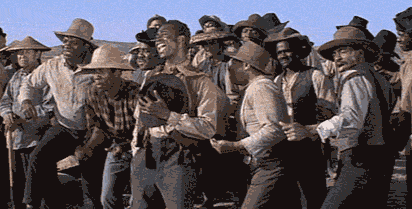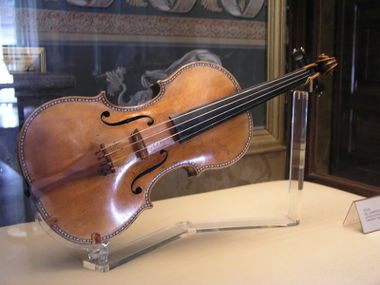Rock and Roll Hall of Fame
Developed as a practical joke, Cleveland's Rock and Roll Hall of Fame opened its doors, no, it threw open its doors, to an adoring public in 1984. They ran and tripped and fell over themselves to finally get into an edifice dedicated to modern-day Gods and Goddesses. And even though some attendees compared it to entering the gates of heaven which led directly to the bowels of hell, some stayed and never left. Thusly born and well on its way to cremation, the Rock and Roll Hall of Fame burst upon the consciousness of museum and theme-park goers everywhere.
Truth be told and spitting gin-soaked saliva into the air, since it was "Rock and Roolllll Dudes!!" it soon left the Louvre, MOMA, The Hermitage, Santa's Village and the Smithstonian covered knee-deep in its unbearably loud gospel inspired hallelujah dust[1].
Cleveland's new soaring and soul-bearing Mount Olympus enchanted a gratified rock fandom and the common hordes of touristy consumer-bots alike from the moment it invited the excited the excitable and the exciting to "Come one come all". And they came, and kept coming - as is the way of Rock. They came in the early years, when the building was stationary, entirely boring and predictable, and accessible from the street. They came in the middle years, when the shrine was improved beyond belief and raised up into the air (but still could be reached by a long staircase). And now the museum, described as either a wonderland or an eerie lucid wet dream by fans lucky to be alive during the core "Rock and Roll era", floats above the Great Lakes during the warmer months and hovers above Cleveland in winter. It is so large that it can be seen from either inner- or outer-space by those who care to glance down.
Where Rock and Roll is King[edit | edit source]

Gawkers, idolists, and nardewells walk the halls to gaze upon leftover trinkets of the lofty, lackadaisical, and loopy. They are encouraged by loudspeakers to try and pry open an exhibit case for a personal memento. Listening to the piped-in or live music found in every corridor, nook and granny of the hall, visitors can't help but tap their toes, swing their hips, and move their other bones around to ancient core rock rhythms used in music all the way from prehistorical log and/or mud-tapping, to the symphonic splendors of radical Europe, to the regionally respected and accelerating technological "stretching the envelope way out there dude" yearning curve encompassing ragtime, gospel, blues, Robert Johnson, Big Band, bee-bop, the Brits, psychedelic, hard-rock, heavy metal, grunge, Garfunkel and Oates, and all the purposely released orchestrations, bootlegs, and bathroom tapes of the lesser well known who moved the spirit from one genre to another. Speeded-up and merged into pleasure and freedom, the tonal neuron-awakening pulsations emerged from triple-layered nervous-system enhancing crescendos of intelligently engineered pure floating sound, developed by Sony, that were now brought to you for some jahforsaken reason by the Cleveland Chamber of Commerce.
From the 1950s until rap bitchslapped the brakes on, Rock reflected the life essence energies of its musicians and vocalists who transmitted brain awakening experiences through the air' until they were absorbed into constantly growing patterns that dedicated listeners, worried parents, the clergy and impressionalble children caught up in the maelstrom came to rely on. They all grew into and with the sound ever since, whether they wanted to or not.
So when the selfishness of the kinda-improved but still lacking in heart capitalistic world gets you and your peeps down, the place to come to for good old school music is the Rock and Roll Hall of Fame. Tickets to its world famous Elvis Presley Stadium are sold at any of the museums seven hundred doors', the only massive stadium in the world that never closes. Its Sound-of-Music-sweet to triple-XXX rated acts are booked months in advance (unless they show up on a whim), and once a week the nights are taken over by cover bands earning tens of millions of dollars a year pretending to be ghosts riding the wind. Every night groupies can corral a faux-Buddy Holly or any number of Bruce Springsteen and Madonna impersonators, and may very well live into the next morning to tell the tale (unless they happen to hook up with either the real or the fake Courtney Love).
Election to the Hall[edit | edit source]
Every five years a secret ballot is distributed to all living members of the Hall of Fame, and these lords and ladies of the muse choose three of their peers to join them. As the glory days of rock recede into the distance, and the voters dwindle to the point where one 97-year old keyboard player headlocked into his "Back in the day" senility is electing Sha-na-na and 50-cent, the Hall will call a halt and accept no new members. But that day is still a few decades in the future, and the living music of new inductees still reverberates throughout the hall's vast canyons and peaks, although some notes sound a bit flat and an ambulance is kept on standby.
Induction Ceremony[edit | edit source]
The annual Inductees Ceremony, or the "Bringing In The Sheep", has changed little since the Hall was a stationary building in the 20th Century.
If the inductee has thrown off the mortal coil[edit | edit source]
If the new addition to the Hall's now 378 inductees is deceased, a Jazz Trumpet solo performed by Louis Armstrong (in person while he lived, on tape since his cheek implosion) is played in the rotunda. The honor guard of past Hall of Fame Inductees and their groupies then parades the new member's plaque into the Hall and presents it to the urn of Chuck Berry for a moment of silence and a moment of loudness. Then, traveling as much as two miles within the structure, they place the plaque in the inductees personalized exhibit room where collections of his or her instruments, written manuscripts, personal belongings, and the usually extraordinarily unhealthy contents of their last meal (if obtainable) rests within close proximity to their skull. The ceremony closes with the "Baking of the Bread", which refers to the "Lighting of the Bong".
If life stirs[edit | edit source]
If the inductee is alive, then hell, all bets are off! They are either led to the Hall believing they're going to get properly laid, brought aboard the Hall for a prearranged press interview, or are drugged and taken aboard while not aware of their surroundings. Then, at a signal from the Hall's president, the "crowds" milling about the Hall shout "Surprise Dude!" and reveal themselves to be all or most of the Hall's living inductees. The shocked new inductee is smothered with hugs and kisses (except in the case of Meatloaf, who was shunned), the first notes of In-A-Gadda-Da-Vida begin to sound, and the inductee is lifted onto the crowd's shoulders, passed around like a $20 whore, and is finally placed at or atop Chuck Berry's urn. There they are formally admitted to the Rock and Roll Hall of Fame amid cheers, and the festivites begin in earnest with the "Baking of the Bread".
Physical layout of the building[edit | edit source]
Because of its constantly shifting shape, and the exterior use of Cuttlefish Paint which changes second-by-second to meld with its surroundings, the building itself is often impossible to identify or detect. This invisibility was built into the design of the original building in the early 1970s in the hope that technology would someday make that possible, which it did in 2023 when Nikola Tesla's notebooks were removed from their secret compartment in Thomas Edison's coffin and finally released to the public.
The three-square-mile Hall of Fame contains 87-stories of exhibits, meeting spaces, theaters, bowling alleys, shopping malls, the giant Sy Roth Casino, ballrooms, replicas of "Graceland", "Neverland" and "Robot Village", the large Presley Stadium for concerts, and the internationally known Rotunda which reaches from the first floor to the roof in one continuous gently-rolling slope. The Rotaunda, home to 111 varities of birds and over 500 species of butterfly, contains artwork along its walls which, when viewed from the exact center of the Hall, tells the entire history of Rock and Roll from a 3-D holographic multi-point-of-view. Smoking hashish is encouraged in the Rotunda, as well as in the rest of the Hall of Fame, and may be purchased in the gift shop near the Hall's entrance.
Growing on the roof of the main building like fungus on Jack Black's toes, the 420-acre Bob Marley Memorial Forest provides camping facilities, waterfalls, and a home to a variety of bear, moose, and endangered wolf species. The building is surrounded by four towers, home to the Hall's administration offices, Inner Sanctum, mausoluem's, historical archives, cockpits, living quarters, assorted Gospel Churches and Temples, at least one Discordian Golden Apple Orchard, and a large manuscript collection of unpublished songs and unreleased recordings dating back to 1952.
Rock and Rollers Lying-in-State[edit | edit source]
Janis Joplin was the first person to lie-in-state in the Hall's rotunda (and the only one to be exhumed and brought to Cleveland for the honor, kicking and hissing the entire way). She was later joined by Keith Richards, Miley Cyrus, Jeff Beck, Madonna, The Rick Brown Experience, the late-in-life combo and suicide pact participants Grace Slick and Bruce Springsteen (interned together in a psychodelic patterned coffin designed by Alex Grey to look like an incense-burner mating with a witch's altar), Gene Simmons, Doug Ingle, Lighthouse, and Robot JY-17.
Since the rotunda soon got verrryyy crowded from an overabundance of caskets, iron platforms, and floral arrangements, the practice was discontinued in 2032. At that point the assembled corpses were buried in Paul McCartney's rooftop pyramid, which already held the remains of twenty-five vegan teen virgins that McCartney insisted on taking with him into the afterlife.
Interesting Events[edit | edit source]
The Boy Who Was Lost For A Long Time[edit | edit source]
In 2029, and this is so typical, a twelve-year-old boy wandered away from his parents while visiting the Hall and wasn't seen again for almost five years. Subsiding on food from the cafeteria dumpsters and some of the seeds that the curators feed the birds and butterflies in the Rotunda, Robin "Wren" Pech learned how to pick the locks to the exhibit cases and then learned how to play guitar. Sleeping during the day and playing Page's, Clapton's, White's and Beck's axes during the night, Pech was soon performing in the Elvis Presley Stadium at least once a week and was known for jamming with hundreds of visiting bands and solo artists in the Hall's vast "Jus' Hangin' Out" rooms. After a year the boy had a fanclub, a website, and several songs on the charts. Police who had been searching for Pech since his disappearence finally found him sleeping with two of his groupies in the Groupie Diorama.
Robin "Wren" Pech was inducted into the Rock and Roll Hall of Fame in 2043.
The Last Stradivarius[edit | edit source]
As most of you well remember and have the scars to prove it, during a brief period in 2027 the world was awash in an anti-music backlash akin to Mao's cultural revolution in ancient China. When all but one of the existing Stradivarius violins were destroyed in what has been called the Night of Broken Strads, old rockers, middle-aged Emos, and some bored guys just looking for kick-ass went to the country home where the last masterpiece reposed. There they fought radical members of Generation WTF to a standstill, saving the instrument. Willed to the Hall after its owners death, the "classy banjo" has been played by tens of thousands who line-up in the Stradivarius Room to take their turn at the helm. Those who can play The Devil Went Down To Georgia reasonably well get to rub Keith Richards for luck and a contact high.
The Crash of '29[edit | edit source]
In the Spring of 2029 the pilot of the Museum "fell asleep" at the wheel, and the entire building slid ashore near Ann Arbor, Michigan. Luckily, no major injuries were reported, but it took over two years to get the building airborne again. Repair crews from every industrialized nation (China, India, Iceland, and Burma) designed a five-mile long ramp on which the building was pulled along on long ropes and cables by Egyptian workers. Near the top of the ramp the Hall's engines started as planned, and the building once again took to the air.
Virtual Reality Vids and Circular Neural Net Implants of the take-off can be purchased in the gift shop.
Also Rock Out to[edit | edit source]
Drum solo[edit | edit source]
References[edit | edit source]
- ↑ Rock and ROOOOOLLLLLLLLLLL!!





